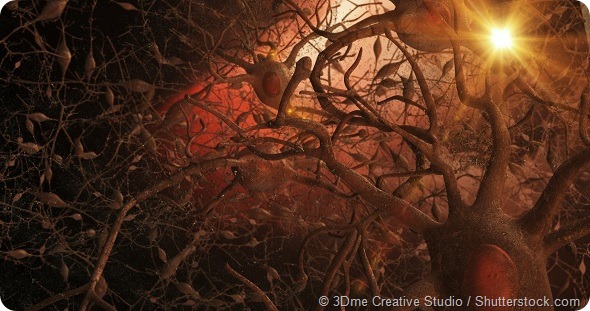There's a tremendous amount known about brain circuit development. Our work was inspired by experiments that were done over 50 years ago by scientists at Harvard University, Hubel and Wiesel. They received a Nobel Prize for their work and have inspired many additional experiments over the last 50 or 60 years.
To advance our understanding about brain circuit development, we identified more of the cellular mechanisms by which sensory experience influences how neurons grow and hook up to other neurons within the circuit.
We found that these events happen earlier in the process of brain development than we had previously thought.

Can you please give an overview of the in vivo time lapse imaging technique you used?
The in vivo time-lapse imaging experiments were absolutely essential to us being able to make this discovery. We used an experimental animal which is a frog tadpole. These animals are transparent during the early stages of development.
Furthermore, they develop externally, so the eggs develop outside of an egg shell or outside of a mom and that means that we have easy access to observe brain development.
For the in vivo time-lapse imaging, we express a naturally occurring fluorescent protein that comes from jellyfish. We take the gene from the jellyfish and we express it in individual brain cells in the tadpole.
Since the protein fluoresces, we can see the shape of that neuron inside the brain of the living tadpole. For the time-lapse imaging process, we anesthetize the tadpole, put it onto the stage of a microscope and take an image of the brain and that neuron inside the brain.
Then, we bring the animal out of anesthesia and let it swim around and get natural visual experience. We then take another image of that same individual neuron inside the brain of that tadpole and we do that several times.
Each time, in-between taking the image, we either put the animal into the dark so it receives no visual experience, or we put it into a little chamber where it receives visual experience. We call it the tadpole disco.
We then have these images of the same neuron over time and we analyze whether or not the shape of that neuron changed in response to the visual experience or the period in the dark.
From our prior studies, what we expected going into this experiment, was that the neurons would basically not change over the period that the animal was in the dark, but that they would grow more as a result of the period when the animal received a visual experience.
Of every animal we know about, there are two general classes of neurons in the brain; those that are excitatory, so they increase the activity of the neurons that they connect to, and those that are inhibitory and decrease the activity of the neurons they're connected to.
What we discovered when we analyzed whether or not the cells we were looking at were either excitatory or inhibitory, was that the inhibitory neurons grew differently than the excitatory neurons in response to visual experience and the dark.
The TSRI Dorris Neuroscience Center, where Dr. Cline serves as director.
What role did stimulation from the outside world play on guiding the neurons’ early development?
Our expectation was that the sensory experience, the visual stimulation, but not the dark would increase connectivity in the brain. We found that the inhibitory neurons actually fell into two classes.
Some of them made stronger connections after the animals was in the dark, and weaker connections after the animal was in the light. That alone was completely unexpected and suggested that there was something new going on that we hadn't really appreciated before these experiments.
Then, when we examined the connectivity more, we realized that these two classes of inhibitory neurons basically perform a “push-pull” kind of function with the excitatory neurons, so they just keep the excitatory neurons from being either too quiet or too active.
Were you surprised by how early the function of inhibitory neurons in developing circuits were defined?
Yes, this was another unexpected discovery that we made. The expectation, again, from many other studies, was that inhibitory neurons begin to play their special role at relatively later stages of brain development. We found that they play a role much earlier on than we expected.
Normally, neurons fall into these different categories and we can recognize that they're different because their shape is different and they express different genes and different proteins.
When we looked at all of these neurons, both the excitatory and the inhibitory neurons together, they looked completely identical, so we couldn't distinguish their properties by these parameters as we expected based on other studies.
The only way we could distinguish them was by how they responded to the visual stimulation and the fact that these inhibitory neurons basically grew more in the dark and grew less with the visual stimulation.
It was only because we collected time-lapse in vivo images, essentially movies, of how neuron connectivity changed in response to the visual stimulation that we realized that they were different.
Are the findings from your study in animal models likely to hold true in humans?
The general principles of brain development that have been discovered in animal models have all been shown to be true in humans. That's not to say that humans are just like these other animals.
Humans have many more capabilities and their brain development is much more complex than any other animal that we've had the opportunity to study, but considering the relative simplicity of these other animals, the basic information that we learn applies to humans.
One of the key things to appreciate about this study is that we looked at brain development at earlier stages than anybody has been able to examine in humans, so we just don't know if these kinds of events occur during human brain development, because we've never had the opportunity to look.
Events comparable to those we studied in tadpoles would be happening very early on in the fetal stages of development.
If the findings do hold true, what impact could this have on treating neurological disorders?
I think there are two types of neurological disorders or problems that could be helped with respect to treatment. One is perinatal brain injury. The basic message that comes out of this study is that sensory experience can help rehabilitate or help the brain develop properly.
One example that followed on from the experiments that I mentioned from 50 or so years ago, is the treatment of a disease that many kids have called amblyopia. That's where one eye doesn't see very well, and the other eye sees just fine.
The treatment that is still used today is to put a patch over the eye that does see well, so that the so-called “lazy eye” has to work harder so that the connections get set up and improve.
That's just like what I would call a rehabilitation program. Now, we think that same principle can be used to help brains recover from injury or if the connections aren't set up properly for some other reasons. We know that we can help repair that damaged brain or that slowly developing brain with sensory experience or rehabilitation.
What further research is needed to understand how much of a neuron’s identity is driven by experience?
Well, I mentioned that the current research defines a neuron's identity, whether it's excitatory or inhibitory, by many features including the genes and proteins that are expressed. We know that hundreds of genes and proteins are changed in neurons when animals have sensory experience.
Understanding what these genes and proteins are and what they do inside cells to help them increase connectivity in response to visual experience, is in my opinion, a huge area that we need to study more. This would help us understand how brain activity helps the connections form.
Where can readers find more information?
- http://www.scripps.edu/cline/
- He, Hai-Yan et al. Experience-Dependent Bimodal Plasticity of Inhibitory Neurons in Early Development. Neuron , Volume 90 , Issue 6 , 1203 - 1214
About Dr Hollis Cline, Hahn Professor of Neuroscience at The Scripps Research Institute

Dr. Cline earned her B.A. in biology from Bryn Mawr College and her Ph.D. in neurobiology from the University of California, Berkeley. She completed postdoctoral positions at Yale University and the Stanford University Medical Center, and she later started her own lab at Cold Spring Harbor Laboratory.
In 2008, Dr. Cline joined The Scripps Research Institute (TSRI), where she currently leads a lab focused on the role of sensory experience in controlling the development, function and plasticity of the visual circuit and how circuit development and function become disrupted in neurodevelopmental disorders.
In 2016, Cline was named chairman of the TSRI Department of Molecular and Cellular Neuroscience and director of TSRI’s Dorris Neuroscience Center. She also serves on the TSRI faculty and has received the TSRI Outstanding Mentor Award for her work in training the next generation of scientists. Other honors include the NIH Director's Pioneer Award and being named AAAS Fellow in 2012.